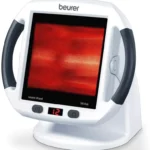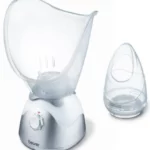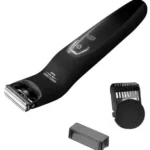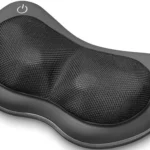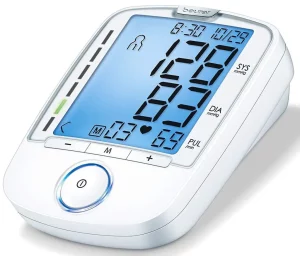

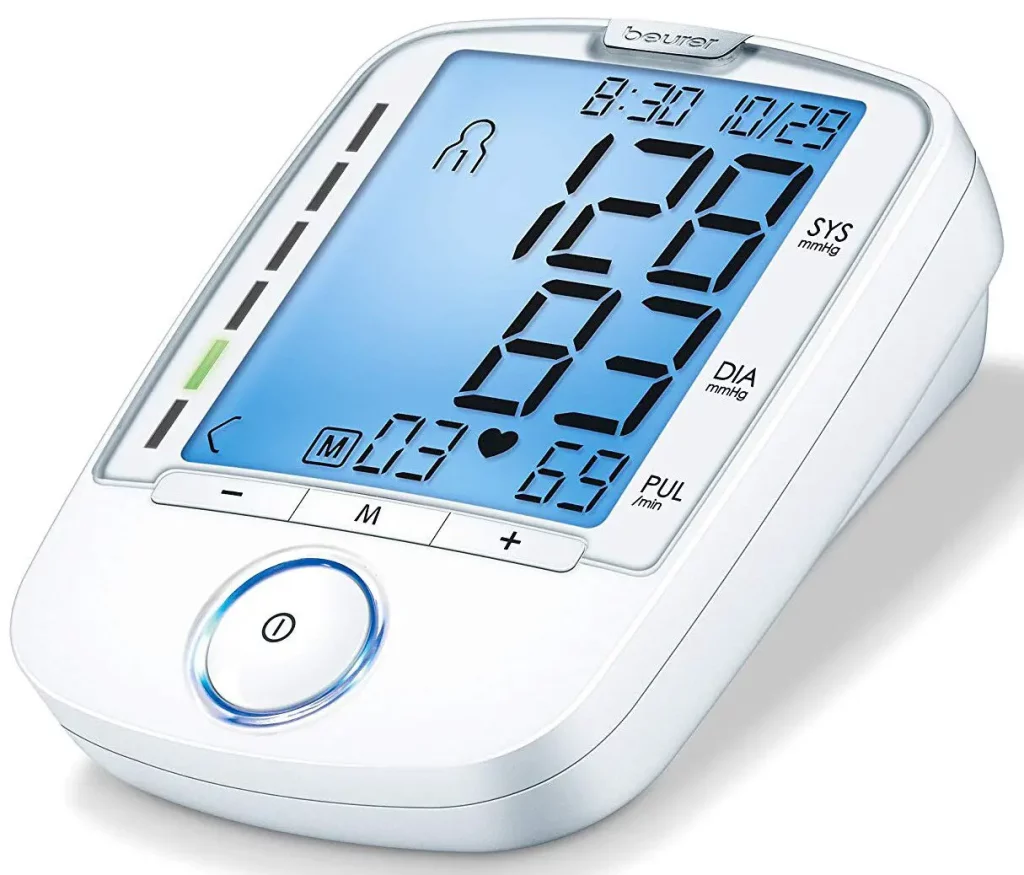
BM 47
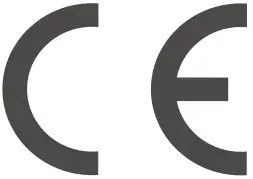 0483
0483
Included in delivery
- Blood pressure monitor
- Upper arm cuff
- 4 x LR6 AA batteries
- Storage bag
- Instructions for use
Dear Customer,
thank you for choosing a product from our range. Our name stands for high-quality, thoroughly tested products for applications in the areas of heat, weight, blood pressure, body temperature, pulse, gentle therapy, massage, beauty and air. Please read these instructions for use carefully and keep them for later use, be sure to make them accessible to other users and observe the information they contain.
Best regards,
Your Beurer Team
1. Getting to know your instrument
Check that the device packaging has not been tampered with and make sure that all contents are present. Before use, ensure that there is no visible damage to the device or accessories and that all packaging material has been removed. If you have any doubts, do not use the device and contact your retailer or the specified Customer Services address.
The upper arm blood pressure monitor is used for noninvasive measurement and monitoring of adults’ arterial blood pressure.
You can use it to measure your blood pressure quickly and easily, storing the results and displaying the progression of readings together with the average.
A warning is issued for anyone suffering from cardiac arrhythmia.
The recorded values are classified and evaluated graphically. Store these instructions for use for future reference and make them accessible to other users.
2. Important information
 Signs and symbols
Signs and symbols
The following symbols are used in these instructions for use, on the packaging and on the type plate for the device and accessories:
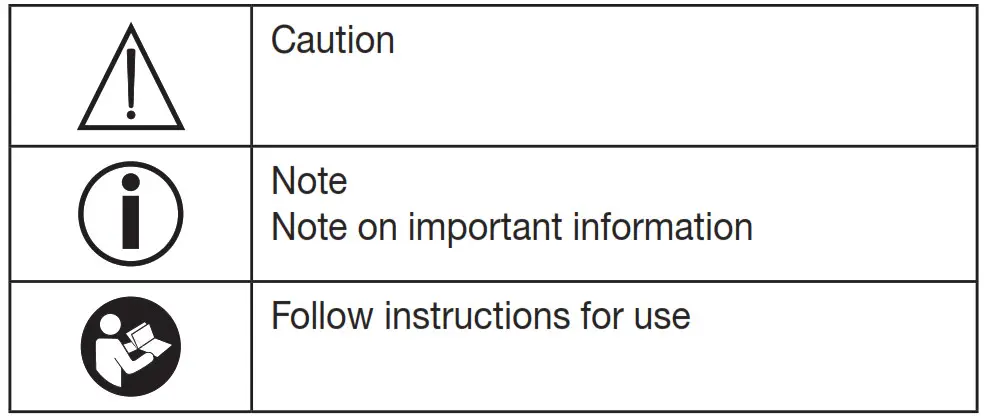
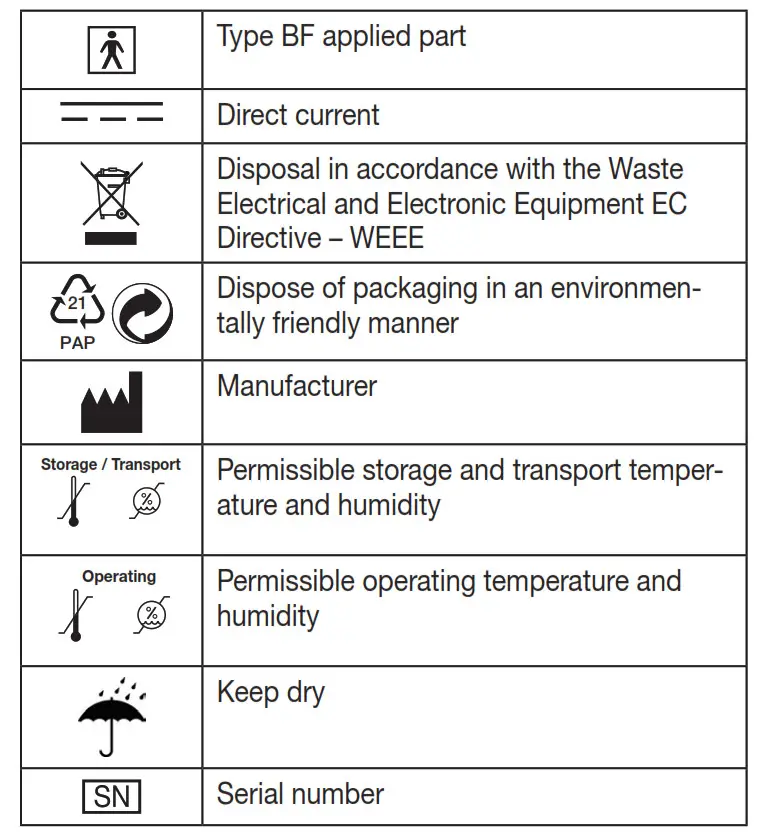
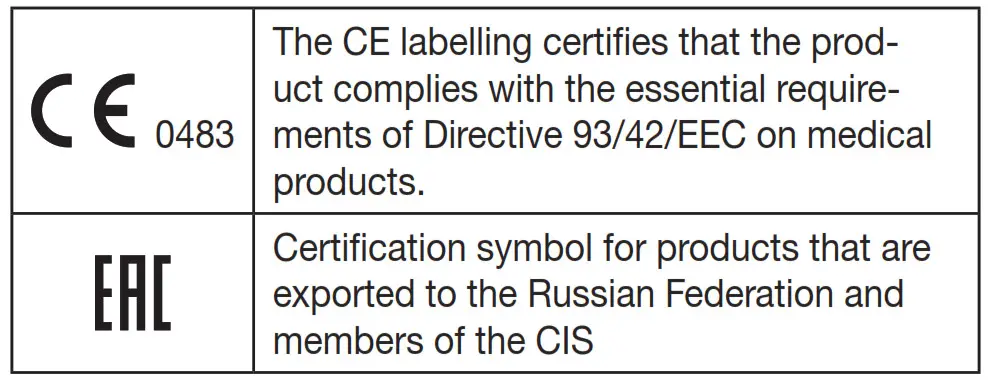
 Advice on use
Advice on use
- In order to ensure comparable values, always measure your blood pressure at the same time of day.
- Before every measurement, relax for about five minutes.
- If you want to perform several measurements on the same person, wait five minutes between each measurement.
- Do not take a measurement within 30 minutes after eating, drinking, smoking, or exercising.
- Repeat the measurement if you are unsure of the measured value.
- The measurements taken by you are for your information only – they are not a substitute for a medical examination! Discuss the measurements with your doctor, and never base any medical decisions on them (e.g. medicines and their administration)!
- Using the blood pressure monitor outside your home environment or whilst on the move (e.g. whilst traveling in a car, ambulance or helicopter, or whilst undertaking physical activity such as playing sport) can influence the measurement accuracy and cause incorrect measurements.
- Do not use the blood pressure monitor on newborns, pregnant women, or patients with preeclampsia.
- Cardiovascular diseases may lead to incorrect measurements or have a detrimental effect on measurement accuracy. The same also applies to very low blood pressure, diabetes, circulatory disorders, and arrhythmias as well as chills or shaking.
- This device is not intended for use by people (including children) with restricted physical, sensory or mental skills or a lack of experience and/or a lack of knowledge unless they are supervised by a person who is responsible for their safety or is instructed by such a person in how to use the device. Supervise children around the device to ensure they do not play with it.
- The blood pressure monitor must not be used in connection with a high-frequency surgical unit.
- Only use the device on people who have the specified upper arm measurement for the device.
- Please note that when inflating, the functions of the limb in question may be impaired.
- During the blood pressure measurement, blood circulation must not be stopped for an unnecessarily long time. If the device malfunctions, remove the cuff from the arm.
- Avoid any mechanical restriction, compression, or bending of the cuff line.
- Do not allow sustained pressure in the cuff or frequent measurements. The resulting restriction of the blood flow may cause injury.
- Ensure that the cuff is not placed on an arm in which the arteries or veins are undergoing medical treatment, e.g. intravascular access or therapy, or an arteriovenous (AV) shunt.
- Do not use the cuff on people who have undergone a mastectomy.
- Do not place the cuff over wounds as this may cause further injury.
- The blood pressure monitor can only be operated with batteries. Please note that data transfer and data storage is only possible when your blood pressure monitor is supplied with power. As soon as the batteries are empty, the blood pressure monitor loses the date and time.
- To conserve the batteries, the monitor switches off auto- matically if no buttons are pressed for one minute.
- The device is only intended for the purpose described in these instructions for use. The manufacturer is not liable for damage resulting from improper or careless use.
 Storage and Care
Storage and Care
- The blood pressure monitor is made up of precision electronic components. Accuracy of readings and the instrument’s service life depend on careful handling.
– You should protect the device from impact, moisture, dirt, major temperature fluctuations, and direct exposure to the sun’s rays.
– Never drop the device.
– Do not use near strong electromagnetic fields, i.e. keep it away from any radio systems and mobile phones.
– Only ever use the cuffs provided with the monitor or original replacement cuffs. Otherwise erroneous results will be recorded. - Do not press any buttons until the cuff is in position.
- If the instrument is not used for any length of time, we recommend removing the batteries.
 Notes on handling batteries
Notes on handling batteries
- If your skin or eyes come into contact with battery fluid, rinse the affected areas with water and seek medical assistance.
 Choking hazard! Small children may swallow and choke on batteries. Store the batteries out of the reach of small children.
Choking hazard! Small children may swallow and choke on batteries. Store the batteries out of the reach of small children.
- Observe the plus (+) and minus (-) polarity signs.
- If a battery has leaked, put on protective gloves and clean the battery compartment with a dry cloth.
- Protect batteries from excessive heat.
 Risk of explosion! Never throw batteries into a fire.
Risk of explosion! Never throw batteries into a fire.- Do not charge or short-circuit batteries.
- If the device is not to be used for a relatively long period, take the batteries out of the battery compartment.
- Use identical or equivalent battery types only.
- Always replace all batteries at the same time.
- Do not use rechargeable batteries.
- Do not disassemble, split or crush the batteries.
 Repair and disposal
Repair and disposal - Batteries do not belong in domestic refuse. Used batteries should be disposed of at the collection points provided.
- Never open the instrument. If these instructions are not heeded, the warranty will be null and void.
- Never attempt to repair the instrument or adjust it your- self. We can no longer guarantee perfect functioning if you do.
- Repairs may only be performed by Customer Service or authorized dealers. However, always check the batteries and replace them if necessary prior to making any complaint.
- For environmental reasons, do not dispose of the device in the household waste at the end of its useful life. Dispose of the unit at a suitable local collection or recycling point. Dispose of the device in accordance with EC Directive – WEEE (Waste Electrical and Electronic Equipment). If you have any questions, please contact the local authorities responsible for waste disposal.
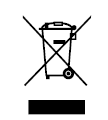
 Notes on electromagnetic compatibility
Notes on electromagnetic compatibility
- The device is suitable for use in all environments listed in these instructions for use, including domestic environments.
- The use of the device may be limited in the presence of electromagnetic disturbances. This could result in issues such as error messages or the failure of the display/device.
- Avoid using this device directly next to other devices or stacked on top of other devices, as this could lead to faulty operation. If, however, it is necessary to use the device in the manner stated, this device as well as the other devices must be monitored to ensure they are working properly.
- The use of accessories other than those specified or pro-vided by the manufacturer of this device can lead to an increase in electromagnetic emissions or a decrease in the device’s electromagnetic immunity; this can result in faulty operation.
- Failure to comply with the above can impair the performance of the device.
3. Unit description
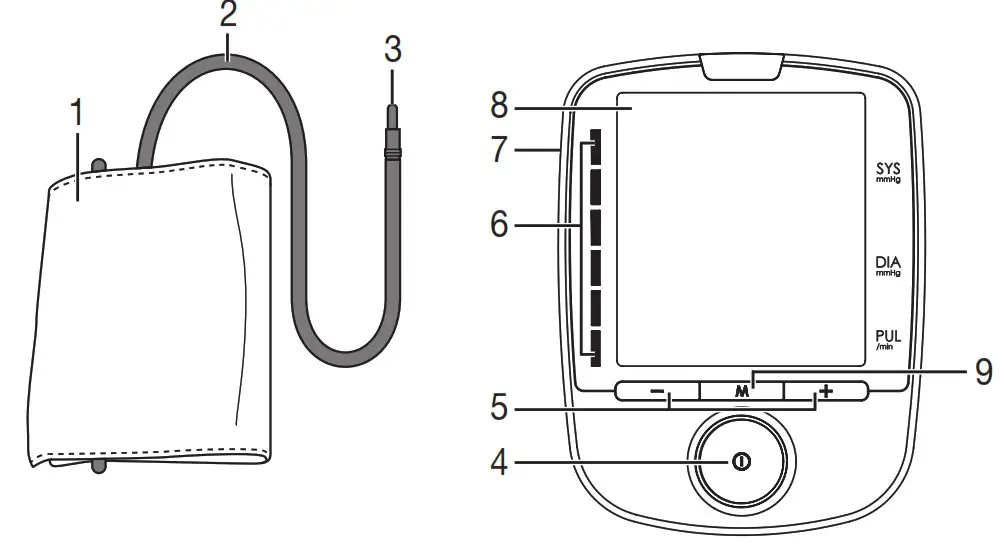
1. Cuff
2. Cuff line
3. Cuff connector
4. START/STOP button
5. function buttons -/+
6. Risk indicator
7. Connection for cuff connector
8. Display
9. Memory button M
Information on the display:
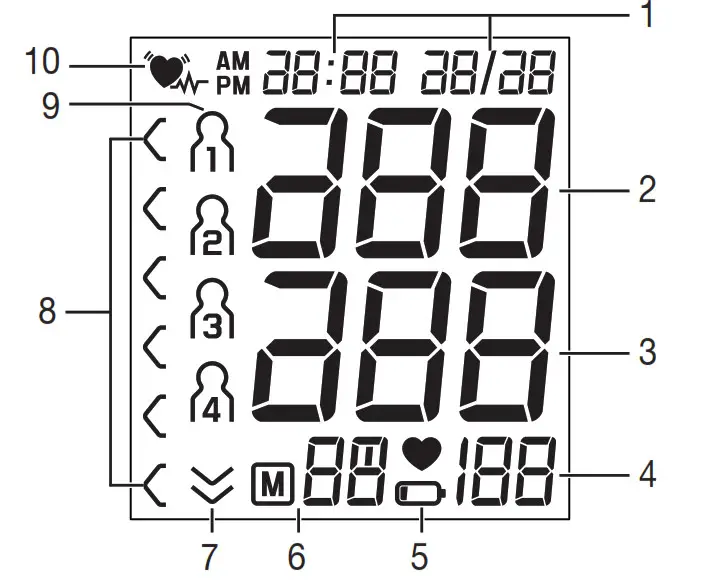
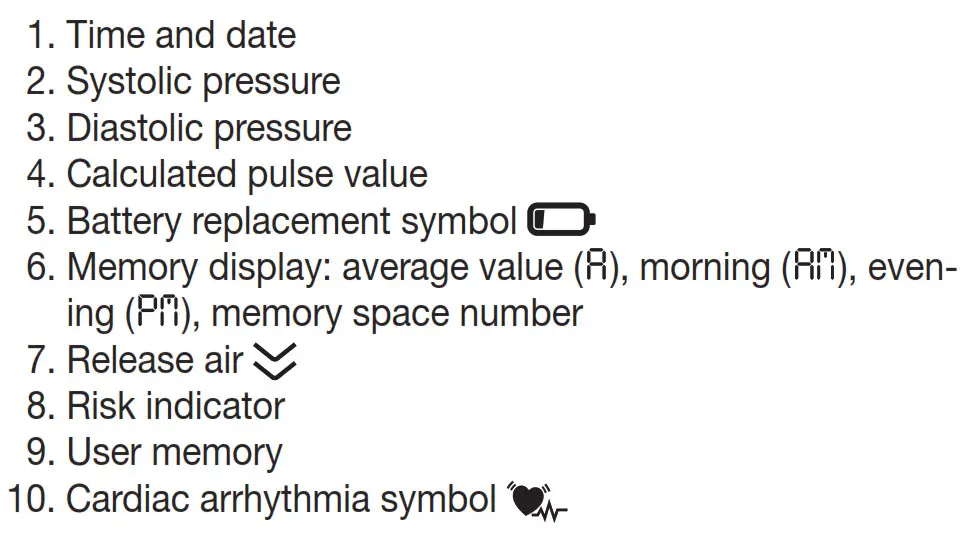
4. Preparing the measurement
Insert the batteries
- Open the battery compartment lid.
- Insert four 1.5 V AA (alkaline type LR6) batteries. Make sure that the batteries are inserted with the correct polarity, according to the label. Do not use rechargeable batteries.

- Close the battery compartment lid again carefully.
- With inserted batteries, the unit permanently displays the time, date and selected user memory.
If the low battery indicator  is permanently displayed, you can no longer perform any measurements and must replace the batteries. Once the batteries have been removed from the unit, the time must be set again.
is permanently displayed, you can no longer perform any measurements and must replace the batteries. Once the batteries have been removed from the unit, the time must be set again.
Used batteries should not be disposed of in normal household waste. Dispose of them via your electronics retailer or your local recycling point. You are legally obligated to do so.
 Battery disposal
Battery disposal
- The empty, completely flat batteries must be disposed of through specially designated collection boxes, recycling points or electronics retailers. You are legally required to dispose of the batteries.
- The codes below are printed on batteries containing harmful substances:
Pb = Battery contains lead,
Cd = Battery contains cadmium,
Hg = Battery contains mercury
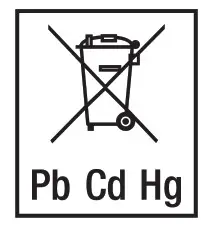
Setting the date and time
It is essential to set the date and time. Otherwise, you will not be able to save your measured values correctly with a date and time and to access them again later.
The time is displayed in the 24-hour format.
To set the date and time, proceed as follows:
- Press the memory button M for at least three seconds.
- The year display will start to flash. Set the year with the function buttons -/+ and confirm with the memory button M.
- Set the month, day, hour and minutes and confirm each setting with the memory button M.
5. Measuring blood pressure
Ensure the device is at room temperature before measuring. The measurement can be performed on the left or right arm.
Attach the cuff
Place the cuff onto the bare upper arm. The circulation of the arm must not be hindered by tight clothing or similar.
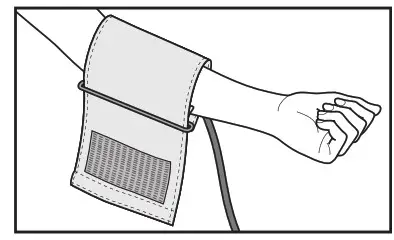
The cuff must be placed on the upper arm so that the bottom edge is positioned 2 – 3 cm above the elbow and over the artery. The line should point to the centre of the palm.
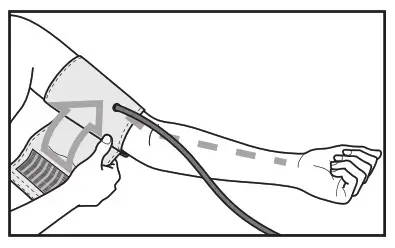
Now tighten the free end of the cuff, but make sure that it is not too tight around the arm and close the hook-and-loop fastener. The cuff should be fastened so that two fingers can fit under the cuff.
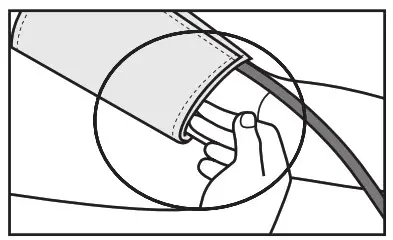
Now insert the cuff line into the connection for the cuff connector.
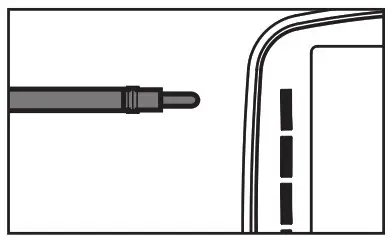
This cuff is suitable for you if the index mark (  ) is within the OK range after fitting the cuff on the upper arm.
) is within the OK range after fitting the cuff on the upper arm.

 If the measurement is performed on the right upper arm, the line should be located on the inside of your elbow. Ensure that your arm is not pressing on the line.
If the measurement is performed on the right upper arm, the line should be located on the inside of your elbow. Ensure that your arm is not pressing on the line.
Blood pressure may vary between the right and left arm, which may mean that the measured blood pressure values are different. Always perform the measurement on the same arm.
If the values between the two arms are significantly different, please consult your doctor to determine which arm should be used for the measurement.
Now insert the cuff line into the connection for the cuff connector.
Caution: The unit may only be operated with the original cuff. The cuff is suitable for an arm circumference of 22 to 35 cm.
A larger cuff for upper arm circumferences from 30 to 42 cm is available from retailers or the service address under order no. 162.795.
Adopt the correct posture

- Before every measurement, relax for about five minutes. Otherwise deviations can occur.
- You can perform the measurement while sitting or lying. Make sure that the cuff is at heart level.
- To carry out a blood pressure measurement, make sure you are sitting comfortably with your arms and back leaning on something. Do not cross your legs. Place your feet flat on the ground.
- To avoid falsifying the measuring result, it is important to remain still during the measurement and not to speak!
Selecting memory
Press the – or + function button. Select the desired user memory (  ) by pressing the -/+ function button. You have 4 memories with 30 spaces each to store the measurements of 4 different people separately. Confirm your selection with the START/STOP button
) by pressing the -/+ function button. You have 4 memories with 30 spaces each to store the measurements of 4 different people separately. Confirm your selection with the START/STOP button .
.
Performing the blood pressure measurement
- As described before, attach the cuff and adopt the posture in which you want to perform the measurement.
- Start the blood pressure monitor with the START/STOP button
 . After the full-screen display, the most recently stored measurement appears. If there is no measurement in the memory, the unit displays the value “0”.
. After the full-screen display, the most recently stored measurement appears. If there is no measurement in the memory, the unit displays the value “0”. - The cuff automatically inflates. The cuff’s air pressure is slowly released. If the device already recognise a ten-dency for high blood pressure, it will reinflate and increase the cuff pressure again. As soon as a pulse is found, the pulse symbol
 is displayed.
is displayed. - Systolic pressure, diastolic pressure and pulse readings are displayed.
- Measuring can be cancelled at any time by pressing the START/STOP button
 .
. _ appears if the measurement has not been performed properly. Take note of the chapter on error messages/trouble-shooting in these instructions for use and repeat the measurement.- The measurement is automatically stored.
- To switch off, press the START/STOP button
 .
.
If you forget to turn off the unit, it will switch off automatically after approx. 1 minute.
Wait at least 5 minutes before taking another measurement.
6. Evaluating results
Cardiac arrhythmia:
This unit can identify potential disruption of the heart rhythm when measuring and if necessary, indicates this after the measurement with the  symbol . This can be an indicator for arrhythmia. Arrhythmia is an illness in which the heart rhythm is abnormal because of flaws in the bioelectrical system that regulates the heartbeat. The symptoms (skipped or premature heart beats, pulse being slow or too fast) can be caused by factors such as heart disease, age, physical make-up, excess stimulants, stress or lack of sleep. Arrhythmia can only be determined through an examination by your doctor. If the symbol
symbol . This can be an indicator for arrhythmia. Arrhythmia is an illness in which the heart rhythm is abnormal because of flaws in the bioelectrical system that regulates the heartbeat. The symptoms (skipped or premature heart beats, pulse being slow or too fast) can be caused by factors such as heart disease, age, physical make-up, excess stimulants, stress or lack of sleep. Arrhythmia can only be determined through an examination by your doctor. If the symbol  is shown on the display after the measurement has been taken, it should be repeated. Please ensure that you rest for 5 minutes beforehand and do not speak or move during the measurement. If the symbol
is shown on the display after the measurement has been taken, it should be repeated. Please ensure that you rest for 5 minutes beforehand and do not speak or move during the measurement. If the symbol  appears frequently, please consult your doctor. Selfdiagnosis and treatment based on the measurements can be dangerous. Always follow your GP’s instructions.
appears frequently, please consult your doctor. Selfdiagnosis and treatment based on the measurements can be dangerous. Always follow your GP’s instructions.
Risk indicator:
The measurements can be classified and evaluated in accordance with the following table. However, these standard values serve only as a general guideline, as the individual blood pressure varies in different people and different age groups etc.
It is important to consult your doctor regularly for advice. Your doctor will tell you your individual values for normal blood pressure as well as the value above which your blood pressure is classified as dangerous.
The bar chart on the display and the scale on the unit show which category the recorded blood pressure values fall into. If the values of systole and diastole fall into two different categories (e.g. systole in the High normal category and diastole in the Normal category), the graphical classification on the device always shows the higher category; for the example given this would be High normal.
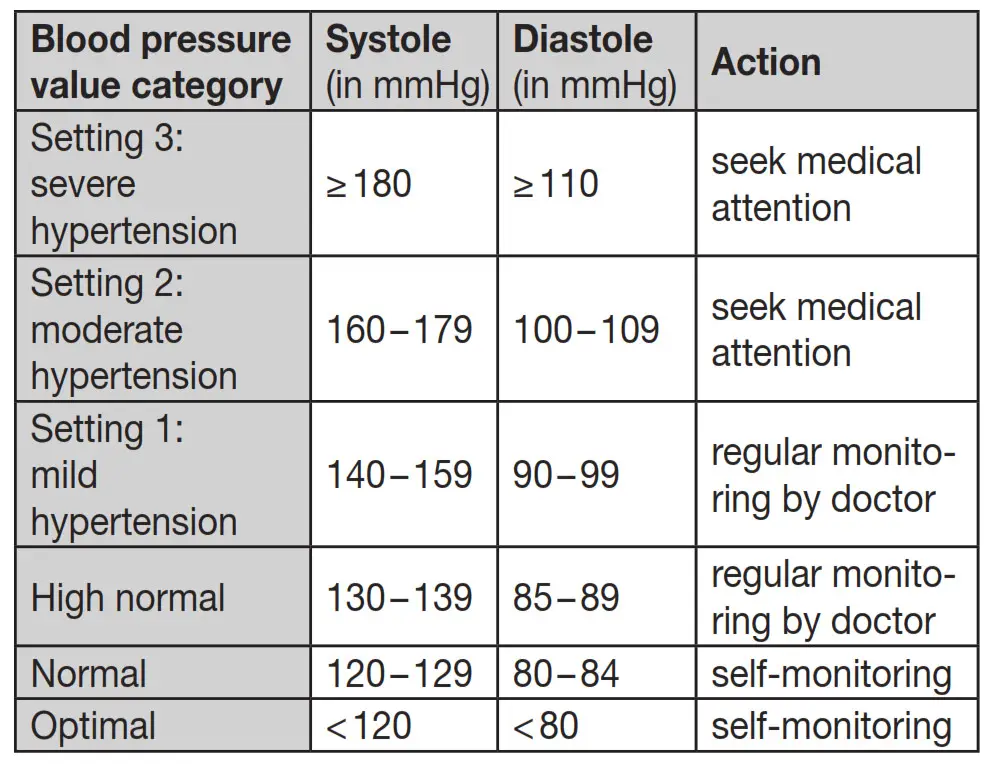
Source: WHO, 1999 (World Health Organization)
7. Saving, displaying and deleting measurements
- The results of every successful measurement are stored together with the date and time. If there are more than 30 measurements, the oldest measurements are lost.
- Press the – or + function button. Select the desired user memory (
 ) by pressing the -/+ function button. Confirm your selection with the START/STOP button
) by pressing the -/+ function button. Confirm your selection with the START/STOP button .
. - If you press the memory button M, the average value of all the stored measured values in the user memory will be displayed. If you press the memory button M again, the average value of the morning measurements for the last 7 days will be displayed. (morning: 5.00 – 9.00, display
). If you press the memory button M again, the average value of the evening measurements for the last 7 days will be displayed. (evening: 18.00 – 20.00, display ). If you continue to press the memory button M, the most recent individual measured values are displayed in turn with the date and time. - You can delete the memory by pressing and holding the memory button M for 3 seconds.
- To switch off, press the START/STOP button
 .
. - If you forget to switch off the unit, it will switch off automatically after 1 minute.
8. Error message/trouble shooting
In the event of errors, the error message _ appears on the display.
Error messages may appear if:
- systolic or diastolic pressure could not be measured (
or - systolic or diastolic pressure was outside the measurement range (
orLo appears on the display) - the cuff is fastened too or loosely (
orappears on the display) - the pump pressure is higher than 300 mmHg (
appears on the display) - pumping up takes longer than 160 seconds (
appears on the display) - there is a system or device error (
appears on the display) - the batteries are almost empty
 .
.
In the above cases, you must repeat the measurement. Make sure that the cuff tube is properly inserted and that you do not move or talk.
Re-insert the batteries if necessary, or else replace them.
 Technical alarm – description
Technical alarm – description
Should the recorded blood pressure (systolic or diastolic) lie outside the limits specified in the section “Technical specifications”, the technical alarm will appear on the display indicating either “ ” or “”. In such cases, you should seek medical assistance and check the accuracy of your procedure.
The limit values for the technical alarm are factory set and cannot be adjusted or deactivated. These alarm limit val-ues are accorded second priority under the standard IEC 60601-1-8.
The technical alarm is a non-locking alarm and must not be reset. The signal shown on the display will disappear automatically after about 8 seconds.
9. Cleaning and storing the device and cuff
- Clean the device and cuff carefully using a slightly damp cloth only.
- Do not use any cleaning agents or solvents.
- Under no circumstances hold the device and cuff under water, as this can cause liquid to enter and damage the device and cuff.
- If you store the device and cuff, do not place heavy objects on the device and cuff. Remove the batteries. The cuff line should not be bent sharply.
10. Technical specifications
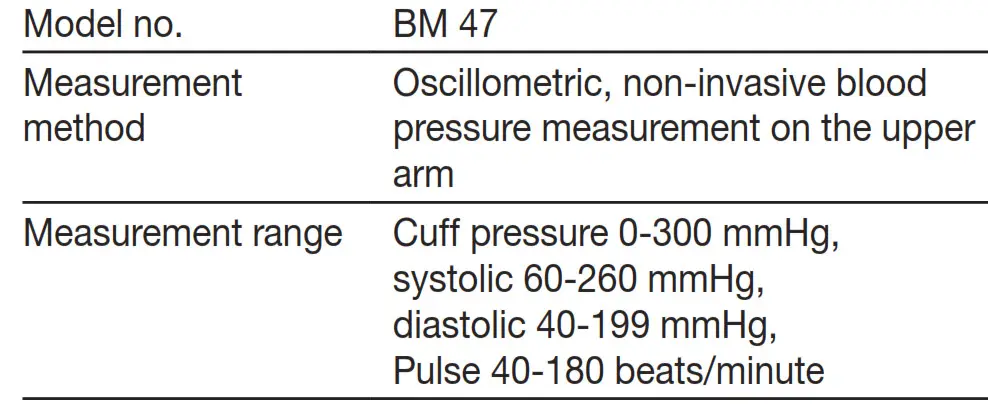
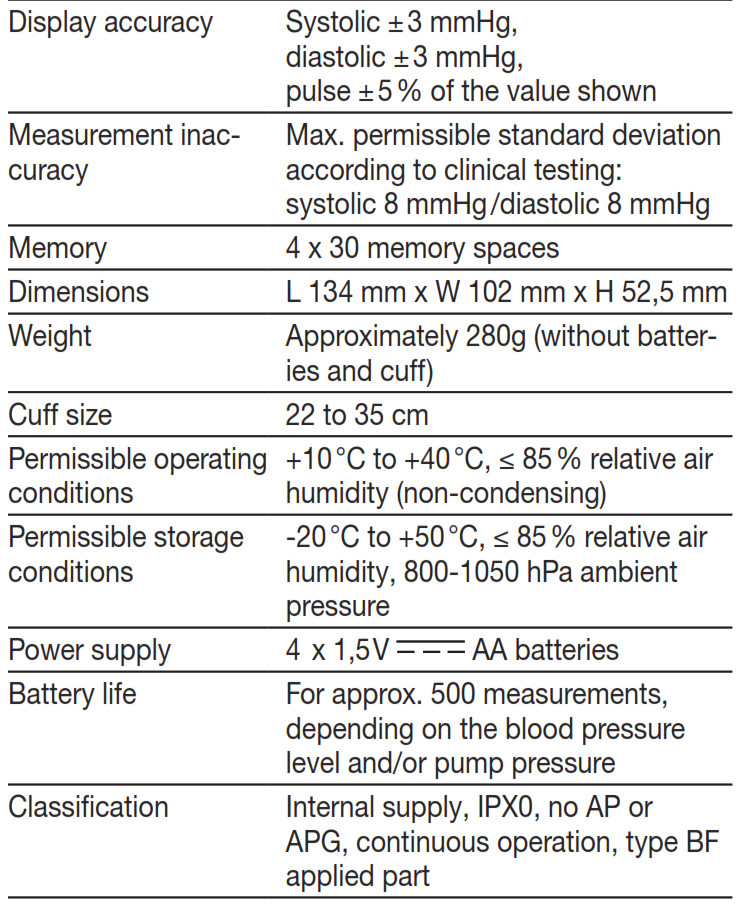
The serial number is located on the device or in the battery compartment.
Technical information is subject to change without notification to allow for updates.
- This unit is in line with European Standard EN 60601-1-2 (In accordance with IEC 61000-4-2, IEC 61000-4-3, IEC 61000-4-4, IEC 61000-4-5, IEC 61000-4-6, IEC 610004-8 and IEC 610004-11) and is subject to particular precautions with regard to electromagnetic compatibility (EMC). Please note that portable and mobile HF communication systems may interfere with this unit.
- This device is in line with the EU Medical Devices Directive 93/42/EEC, the „Medizinproduktegesetz“ (German Medical Devices Act) and the standards EN 1060-1 (noninvasive sphygmomanometer, Part 1: General requirements), EN 1060-3 (non-invasive sphygmomanometer, Part 3: Supplementary requirements for electro-mechanical blood pressure measuring systems) and IEC 80601-230 (Medical electrical equipment – Part 2 – 30: Particular requirements for the safety and essential performance of automated non-invasive blood pressure monitors).
- The accuracy of this blood pressure monitor has been carefully checked and developed with regard to a long useful life. If using the device for commercial medical purposes, it must be regularly tested for accuracy by appro-priate means. Precise instructions for checking accuracy may be requested from the service address.
11. Replacement parts and wearing parts
Replacement parts and wearing parts are available from the corresponding listed service address under the stated material number.

12. Warranty / service
In case of a claim under the warranty please contact your local dealer or the local representation which is mentioned in the list “service international”.
In case of returning the unit please add a copy of your receipt and a short report of the defect.
The following warranty terms shall apply:
- The warranty period for BEURER products is either 5 years or- if longer- the country specific warranty period from date of Purchase.
In case of a warranty claim, the date of purchase has to be proven by means of the sales receipt or invoice. - Repairs (complete unit or parts of the unit) do not extend the warranty period.
- The warranty shall not be valid for damages because of
a. improper treatment, e.g. nonobservance of the user instructions.
b. repairs or tampering by the customer or unauthorised third parties.
c. transport from the manufacturer to the consumer or during transport to the service centre.
d. The warranty shall not be valid for accessories which are subject to normal wear and tear (cuff, batteries etc.). - Liability for direct or indirect consequential losses caused by the unit are excluded even if the damage to the unit is accepted as a warranty claim.
